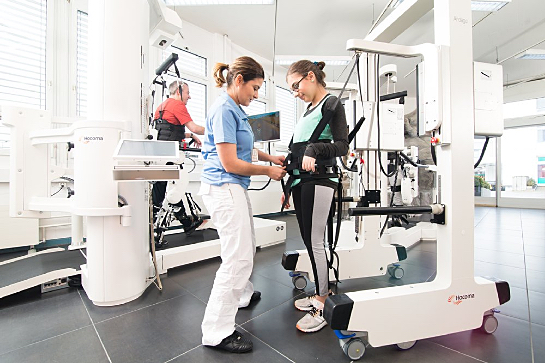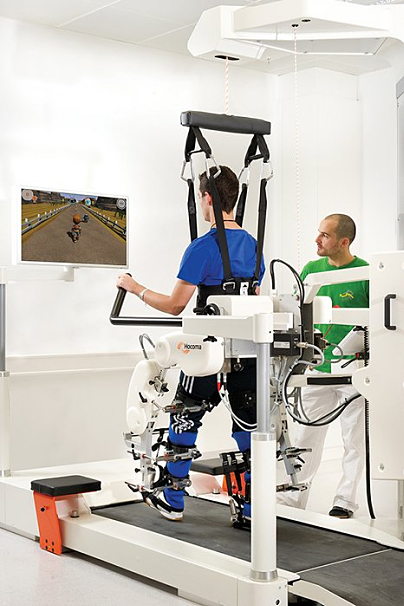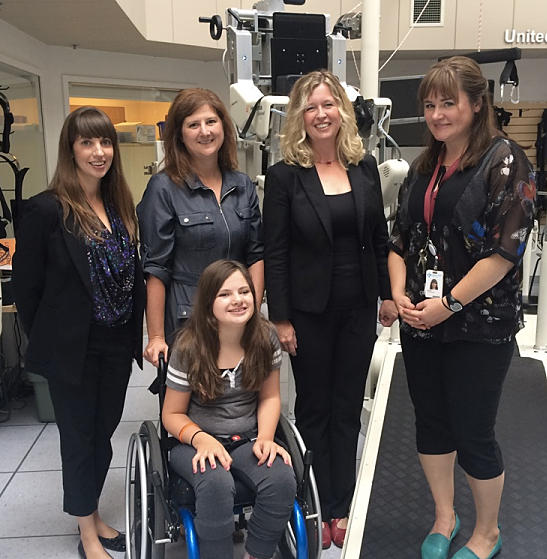Robotic Gait Training for Kids with Cerebral Palsy: Is It Really Effective?

 Researchers at Canada’s University of Alberta Faculty of Rehabilitation Medicine are investigating the effectiveness of a gait training program on a robotic device called Lokomat compared to regular physical therapy for enhancing walking abilities in pediatric cerebral palsy (CP) patients.
Researchers at Canada’s University of Alberta Faculty of Rehabilitation Medicine are investigating the effectiveness of a gait training program on a robotic device called Lokomat compared to regular physical therapy for enhancing walking abilities in pediatric cerebral palsy (CP) patients.
The research is being conducted at the Glenrose Rehabilitation Hospital in Edmonton, Alberta, the largest free-standing, comprehensive rehabilitation hospital in Canada addressing the needs of patients of all ages who require complex rehabilitation.
 The Canadian Institutes of Health Research (CIHR)-funded randomized control trial is being led by Lesley Wiart, an assistant professor of physical therapy at the Faculty of Rehabilitation Medicine and a research associate at the Glenrose Rehabilitation Hospital. Wiart and her team are currently recruiting children and teens with cerebral palsy ages 5 to 18 who walk with or without handheld walkers. Interested families are invited to contact lokomatstudy @ualberta.ca or call 780-492-9098.
The Canadian Institutes of Health Research (CIHR)-funded randomized control trial is being led by Lesley Wiart, an assistant professor of physical therapy at the Faculty of Rehabilitation Medicine and a research associate at the Glenrose Rehabilitation Hospital. Wiart and her team are currently recruiting children and teens with cerebral palsy ages 5 to 18 who walk with or without handheld walkers. Interested families are invited to contact lokomatstudy @ualberta.ca or call 780-492-9098.
 The Lokomat robotic gait device is a product of Hocoma, headquartered in Volketswil, near Zürich, Switzerland, with subsidiaries in the U.S., Singapore, and Slovenia. Hocoma says Lokomat supports an optimized physiological gait pattern, providing constant feedback and therapy assessments, and improving patient outcomes by increasing therapy volume and intensity over time, providing task-specific training and increasing patient engagement.
The Lokomat robotic gait device is a product of Hocoma, headquartered in Volketswil, near Zürich, Switzerland, with subsidiaries in the U.S., Singapore, and Slovenia. Hocoma says Lokomat supports an optimized physiological gait pattern, providing constant feedback and therapy assessments, and improving patient outcomes by increasing therapy volume and intensity over time, providing task-specific training and increasing patient engagement.
Photo courtesy Hocoma, Switzerland
In 2010, Hocoma launched a version of the Lokomat system more compact than the original LokomatPro device called the LokomatNanos. Like the LokomatPro, it is designed to improve training efficiency compared with conventional manually assisted therapy. The device is equipped with all the features needed to provide effective robotic gait training.
 The Lokomat’s driven robotic gait orthosis legs guide the child through walking movements on a treadmill, supporting the body weight so they move their legs more freely. Body weight support and the amount of guidance is decreased over time to more closely replicate regular unassisted walking. A video game connected to the Lokomat provides feedback on the amount of force the child is generating.
The Lokomat’s driven robotic gait orthosis legs guide the child through walking movements on a treadmill, supporting the body weight so they move their legs more freely. Body weight support and the amount of guidance is decreased over time to more closely replicate regular unassisted walking. A video game connected to the Lokomat provides feedback on the amount of force the child is generating.
The robotic device is designed to promote faster progress through longer and more intensive training sessions compared to manually assisted therapy, with less physical strain on therapists. The device’s basic walking indicator supports monitoring and improved motivation through visualized performance feedback.
Photo courtesy Hocoma, Switzerland
“Research evidence for robotic gait training for children with cerebral palsy is limited,” Wiart said in a University of Alberta news release. “We are doing this study so that families and clinicians have information about effectiveness and they can make informed decisions about physical therapy treatment.”
 Wiart, who has also teamed up with Virginia Wright, a senior scientist at the Bloorview Research Institute in Toronto, Ontario, said the study’s qualitative component comparing different interventions to see which are more effective is being conducted at three sites: Glenrose Rehabilitation Hospital; Holland Bloorview Kids Rehabilitation Hospital in Toronto; and the Rehabilitation Institute of Chicago. Kids and teens with cerebral palsy participating in the study will be assigned to one of four groups which will receive either robotic-assisted gait training, conventional physical therapy, a combination of robotic-assisted gait training and conventional physical therapy, and the control group, which receives no treatment in the study.
Wiart, who has also teamed up with Virginia Wright, a senior scientist at the Bloorview Research Institute in Toronto, Ontario, said the study’s qualitative component comparing different interventions to see which are more effective is being conducted at three sites: Glenrose Rehabilitation Hospital; Holland Bloorview Kids Rehabilitation Hospital in Toronto; and the Rehabilitation Institute of Chicago. Kids and teens with cerebral palsy participating in the study will be assigned to one of four groups which will receive either robotic-assisted gait training, conventional physical therapy, a combination of robotic-assisted gait training and conventional physical therapy, and the control group, which receives no treatment in the study.
“We are interested in how the treatment affects walking, but also how it affects the child’s confidence to participate in physical activities and their participation in other activities in their homes and communities,” Wiart said.
“In the qualitative part, we will talk to parents and children about their beliefs and values about walking and why their mobility goals are important to them. It is essential to understand families’ goals and values about walking, because many families are more focused on ensuring their child can move around effectively and are less focused on how their child moves,” she said.
 “To date, there has been a very limited amount of qualitative research focusing on parents’ and even more so children’s perspectives on and experiences with robotic gait training interventions. In particular, children’s voices are often left out,” said Shanon Phelan, assistant professor in the UofA Faculty of Rehabilitation Medicine’s Department of Occupational Therapy, and a member of Wiart’s team of investigators.
“To date, there has been a very limited amount of qualitative research focusing on parents’ and even more so children’s perspectives on and experiences with robotic gait training interventions. In particular, children’s voices are often left out,” said Shanon Phelan, assistant professor in the UofA Faculty of Rehabilitation Medicine’s Department of Occupational Therapy, and a member of Wiart’s team of investigators.
“Robotic gait training interventions are becoming more and more popular, especially for parents who are seeking out the newest technologies and interventions. We tend to assume all children want to walk or use a robot because it’s cool, but that’s not always the case and it’s important to listen to the child’s perspective on this.”
The release cites Doreen Slessor, mother of 12-year-old study participant Maggie Slessor, saying, “I’ve seen how the Lokomat has motivated Maggie and given her confidence. It’s also helped her have more confidence walking with a cane. She’ll probably give me a hard time for saying this, but it’s also helped with her gut motility!”
Maggie Slessor with (left to right) researcher Shanon Phelan, mom Doreen, researcher Lesley Wiart, and physical therapist Kelsey Switzer. Photo courtesy University of Alberta
The Lokomat device being used in the study’s Edmonton component is provided by the Glenrose Rehabilitation Hospital Foundation. John Andersen and Rhonda Rosychuk are also part of Wiart’s Edmonton research team.



